Ionic Liquid as Dispersing Agent of LDH-Carbon Nanotubes into a Biodegradable Vinyl Alcohol Polymer
Abstract
1. Introduction
2. Materials and Methods
2.1. Materials
2.2. Preparation of ZnAl-CNTs by Co-Precipitation Method
2.3. Preparation of Ionic Liquid (IL)
2.3.1. 1-Hexadecyl-3-methyl Imidazolium Bromide (Hdmim Br) Synthesis
2.3.2. 1-Hexadecyl-3-methyl Imidazolium Dimethyl-5-sulfoisophthalate (Hdmim DMSIP) Synthesis
2.4. Preparation of Composites
2.5. Methods of Investigation
3. Results
3.1. Filler Characterization
3.2. Composites Characterization
4. Conclusions
Author Contributions
Funding
Conflicts of Interest
References
- Sahoo, N.G.; Rana, S.; Cho, J.W.; Li, L.; Chan, S.H. Polymer nanocomposites based on functionalized carbon nanotubes. Prog. Polym. Sci. 2010, 35, 837–867. [Google Scholar] [CrossRef]
- Spitalsky, Z.; Tasis, D.; Papagelis, K.; Galiotis, C. Carbon nanotube–polymer composites: Chemistry, processing, mechanical and electrical properties. Prog. Polym. Sci. 2010, 35, 357–401. [Google Scholar] [CrossRef]
- Dintcheva, N.Tz.; Arrigo, R.; Carroccio, S.; Curcuruto, G.; Guenzi, M.; Gambarotti, C.; Filippone, G. Multi-functional polyhedral oligomeric silsesquioxane-functionalized carbon nanotubes for photo-oxidative stable Ultra-High Molecular Weight Polyethylene-based nanocomposites. Eur. Polym. J. 2016, 75, 525–537. [Google Scholar] [CrossRef]
- Gorrasi, G.; Milone, C.; Piperopoulos, E.; Lanza, M.; Sorrentino, A. Hybrid clay mineral-carbon nanotube-PLA nanocomposite films. Preparation and photodegradation effect on their mechanical, thermal and electrical properties. Appl. Clay Sci. 2013, 71, 49–54. [Google Scholar] [CrossRef]
- Zakaria, M.R.; Md Akil, H.; Abdul Kudus, M.H.; Ullah, F.; Javed, F.; Nosbi, N. Hybrid carbon fiber-carbon nanotubes reinforced polymer composites: A review. Compos. Part B Eng. 2019, 176, 107313. [Google Scholar] [CrossRef]
- Byrne, M.T.; Gun’ko, Y.K. Recent Advances in Research on Carbon Nanotube-Polymer Composites. Adv. Mater. 2010, 22, 1672–1688. [Google Scholar] [CrossRef]
- Blake, R.; Coleman, J.N.; Byrne, M.T.; McCarthy, J.E.; Perova, T.S.; Blau, W.J.; Fonseca, A.; Nagy, J.B.; Gun’ko, Y.K. Reinforcement of poly(vinyl chloride) and polystyrene using chlorinated polypropylene grafted carbon nanotubes. J. Mater. Chem. 2006, 16, 4206. [Google Scholar] [CrossRef]
- Blond, D.; Barron, V.; Ruether, M.; Ryan, K.P.; Nicolosi, V.; Blau, W.J.; Coleman, J.N. Enhancement of Modulus, Strength, and Toughness in Poly(methyl methacrylate)-Based Composites by the Incorporation of Poly(methyl methacrylate)-Functionalized Nanotubes. Adv. Funct. Mater. 2006, 16, 1608–1614. [Google Scholar] [CrossRef]
- Yang, B.-X.; Pramoda, K.P.; Xu, G.Q.; Goh, S.H. Mechanical Reinforcement of Polyethylene Using Polyethylene-Grafted Multiwalled Carbon Nanotubes. Adv. Funct. Mater. 2007, 17, 2062–2069. [Google Scholar] [CrossRef]
- Yang, B.-X.; Shi, J.-H.; Pramoda, K.P.; Goh, S.H. Enhancement of the mechanical properties of polypropylene using polypropylene-grafted multiwalled carbon nanotubes. Compos. Sci. Technol. 2008, 68, 2490–2497. [Google Scholar] [CrossRef]
- Xing, W.; Yang, W.; Yang, W.; Hu, Q.; Si, J.; Lu, H.; Yang, B.; Song, L.; Hu, Y.; Yuen, R.K.K. Functionalized Carbon Nanotubes with Phosphorus- and Nitrogen-Containing Agents: Effective Reinforcer for Thermal, Mechanical, and Flame-Retardant Properties of Polystyrene Nanocomposites. ACS Appl. Mater. Interfaces 2016, 8, 26266–26274. [Google Scholar] [CrossRef] [PubMed]
- Tsang, S.C.; Chen, Y.K.; Harris, P.J.F.; Green, M.L.H. A simple chemical method of opening and filling carbon nanotubes. Nature 1994, 372, 159–162. [Google Scholar] [CrossRef]
- Mishra, G.; Dash, B.; Pandey, S. Layered double hydroxides: A brief review from fundamentals to application as evolving biomaterials. Appl. Clay Sci. 2018, 153, 172–186. [Google Scholar] [CrossRef]
- Pradhan, B.; Srivastava, S.K. Layered double hydroxide/multiwalled carbon nanotube hybrids as reinforcing filler in silicone rubber. Compos. Part A Appl. Sci. Manuf. 2014, 56, 290–299. [Google Scholar] [CrossRef]
- Mallakpour, S.; Dinari, M. Hybrids of Mg–Al-layered double hydroxide and multiwalled carbon nanotube as a reinforcing filler in the l-phenylalanine-based polymer nanocomposites. J. Therm. Anal. Calorim. 2015, 119, 1905–1912. [Google Scholar] [CrossRef]
- Si, J.; Ping, P.; Xie, H.; Yang, W.; Lu, H. The influence of multiwalled carbon nanotubes-NiCoAl layered double hydroxide hybrids on fire safety performance of poly(ethylene-co-vinyl acetate) composites. Polym. Compos. 2018, 39, E835–E841. [Google Scholar] [CrossRef]
- Yan, N.; Capezzuto, F.; Buonocore, G.G.; Lavorgna, M.; Xia, H.; Ambrosio, L. Gas-Barrier Hybrid Coatings by the Assembly of Novel Poly(vinyl alcohol) and Reduced Graphene Oxide Layers through Cross-Linking with Zirconium Adducts. ACS Appl. Mater. Interfaces 2015, 7, 22678–22685. [Google Scholar] [CrossRef]
- Fukushima, T.; Aida, T. Ionic Liquids for Soft Functional Materials with Carbon Nanotubes. Chem. Eur. J. 2007, 13, 5048–5058. [Google Scholar] [CrossRef]
- Hameed, N.; Church, J.S.; Salim, N.V.; Hanley, T.L.; Amini, A.; Fox, B.L. Dispersing single-walled carbon nanotubes in ionic liquids: a quantitative analysis. RSC Adv. 2013, 3, 20034. [Google Scholar] [CrossRef]
- Polo-Luque, M.L.; Simonet, B.M.; Valcárcel, M. Functionalization and dispersion of carbon nanotubes in ionic liquids. TrAC Trends Anal. Chem. 2013, 47, 99–110. [Google Scholar] [CrossRef]
- Bordes, E.; Morcos, B.; Bourgogne, D.; Andanson, J.-M.; Bussière, P.-O.; Santini, C.C.; Benayad, A.; Costa Gomes, M.; Pádua, A.A.H. Dispersion and Stabilization of Exfoliated Graphene in Ionic Liquids. Front. Chem. 2019, 7, 223. [Google Scholar] [CrossRef] [PubMed]
- Fileti, E.E.; Chaban, V.V. Imidazolium Ionic Liquid Helps to Disperse Fullerenes in Water. J. Phys. Chem. Lett. 2014, 5, 1795–1800. [Google Scholar] [CrossRef] [PubMed]
- Soares, B.G. Ionic liquid: A smart approach for developing conducting polymer composites. J. Mol. Liq. 2018, 262, 8–18. [Google Scholar] [CrossRef]
- Soares da Silva, J.P.; Soares, B.G.; Livi, S.; Barra, G.M.O. Phosphonium–based ionic liquid as dispersing agent for MWCNT in melt-mixing polystyrene blends: Rheology, electrical properties and EMI shielding effectiveness. Mater. Chem. Phys. 2017, 189, 162–168. [Google Scholar] [CrossRef]
- Rashid, Z.; Wilfredand, C.D.; Murugesan, T. Effect of hydrophobic Ionic Liquids on Petroleum Asphaltene Dispersion and Determination Using UV-Visible Spectroscopy. AIP Conf. Proc. 2017, 1891, 020118. [Google Scholar] [CrossRef]
- Frunza, M.; Lisa, G.; Popa, M.I.; Miron, N.D.; Nistor, D.I. Thermogravimetric analysis of layered double hydroxides with chloramphenicol and salicylate in the interlayer space. J. Therm. Anal. Calorim. 2008, 93, 373–379. [Google Scholar] [CrossRef]
- Oswald, H.R.; Asper, R. Bivalent Metal Hydroxides. In Preparation and Crystal Growth of Materials with Layered Structures; Lieth, R.M.A., Ed.; Springer Netherlands: Dordrecht, The Netherlands, 1977; pp. 71–140. ISBN 978-90-481-8344-9. [Google Scholar]
- Rad, F.A.; Rezvani, Z. Preparation of cubane-1,4-dicarboxylate–Zn–Al layered double hydroxide nanohybrid: comparison of structural and optical properties between experimental and calculated results. RSC Adv. 2015, 5, 67384–67393. [Google Scholar] [CrossRef]
- Giordano, C.; Filatrella, G.; Sarno, M.; Bartolomeo, A.D. Multi-walled carbon nanotube films for the measurement of the alcoholic concentration. Micro. Nano. Lett. 2019, 14, 304–308. [Google Scholar] [CrossRef]
- Gorrasi, G.; Bugatti, V.; Milone, C.; Mastronardo, E.; Piperopoulos, E.; Iemmo, L.; Di Bartolomeo, A. Effect of temperature and morphology on the electrical properties of PET/conductive nanofillers composites. Compos. Part B Eng. 2018, 135, 149–154. [Google Scholar] [CrossRef]
- Tunnicliffe, L.B.; Kadlcak, J.; Morris, M.D.; Shi, Y.; Thomas, A.G.; Busfield, J.J.C. Flocculation and Viscoelastic Behaviour in Carbon Black-Filled Natural Rubber: Flocculation and Viscoelastic Behaviour in Carbon Black-Filled. Macromol. Mater. Eng. 2014, 299, 1474–1483. [Google Scholar] [CrossRef]
- Bauhofer, W.; Kovacs, J.Z. A review and analysis of electrical percolation in carbon nanotube polymer composites. Compos. Sci. Technol. 2009, 69, 1486–1498. [Google Scholar] [CrossRef]
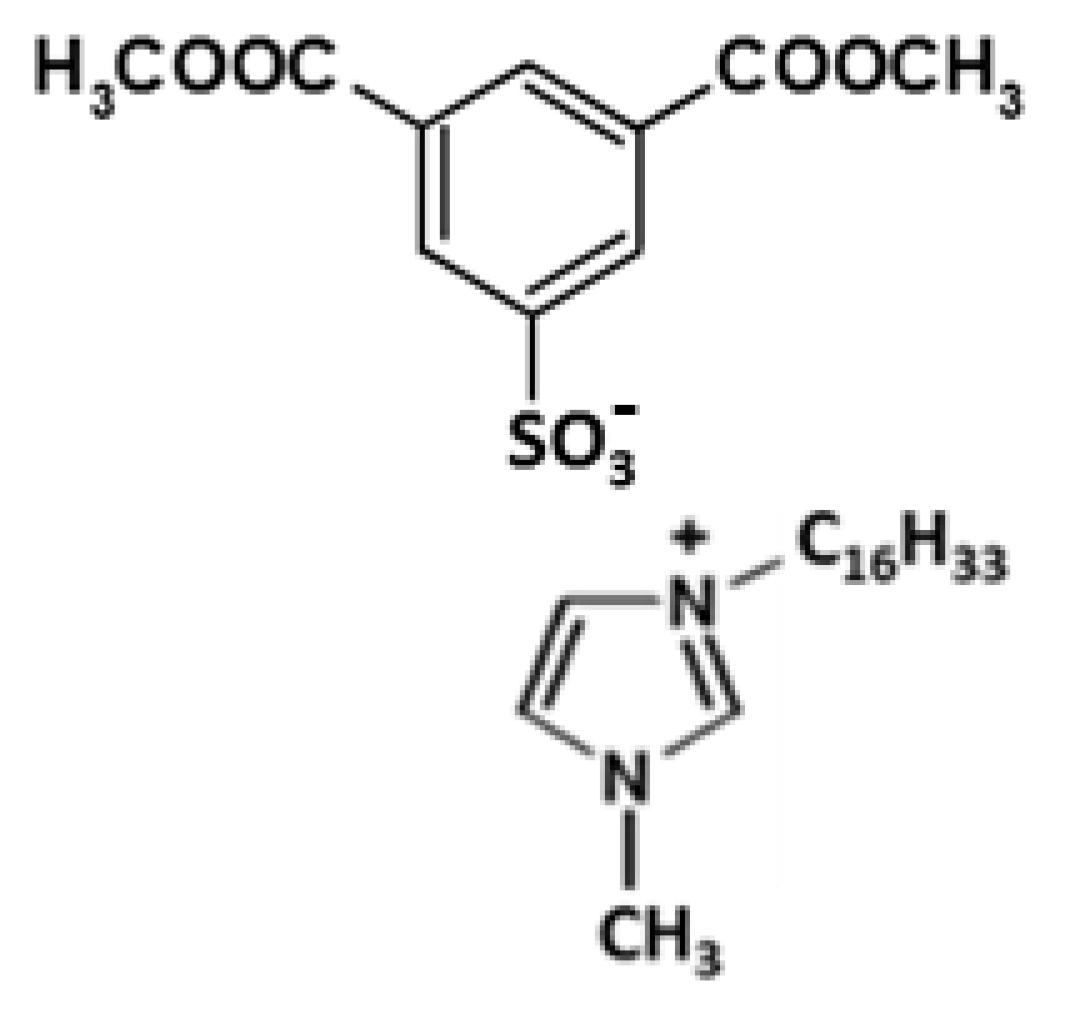

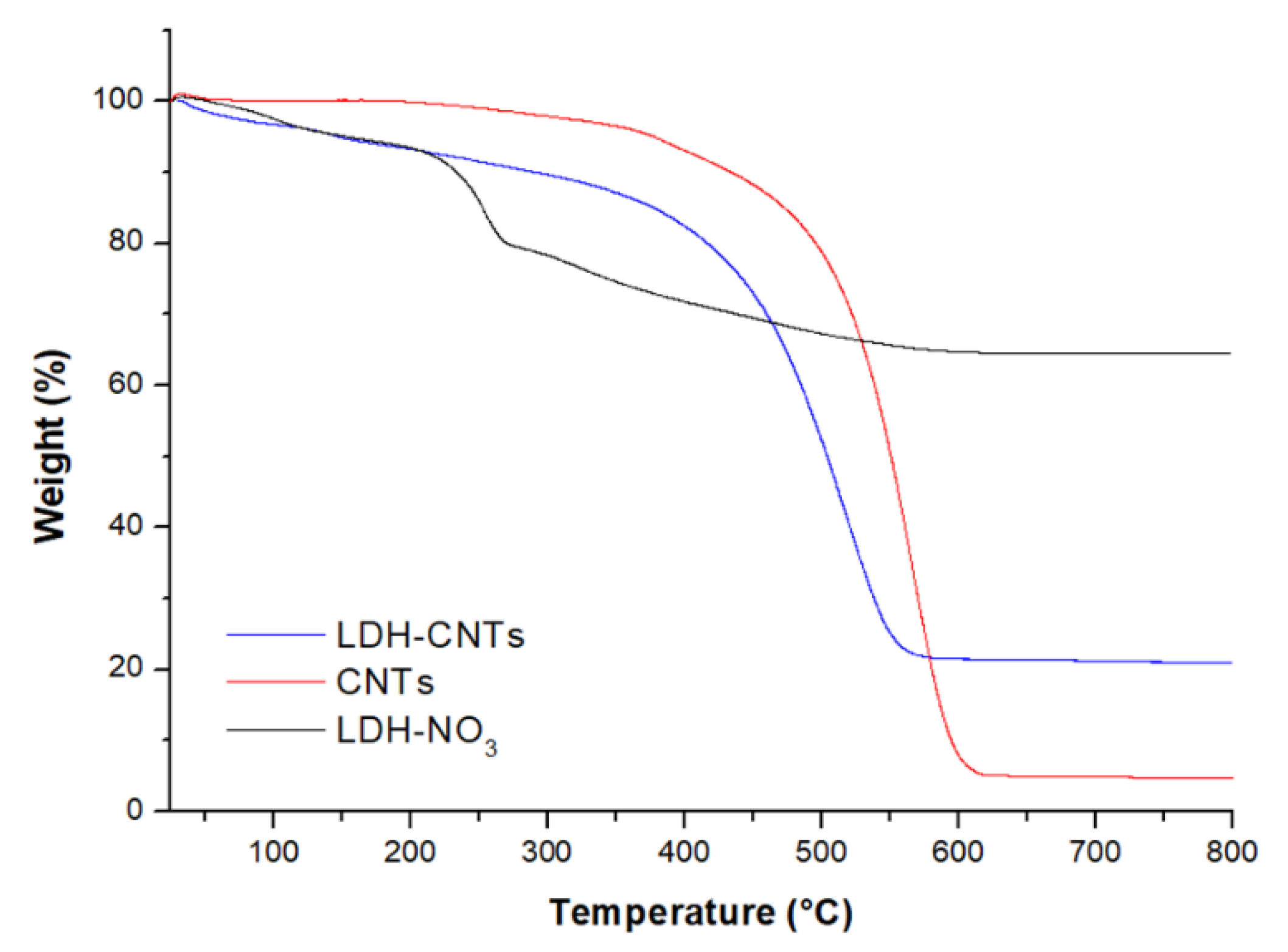
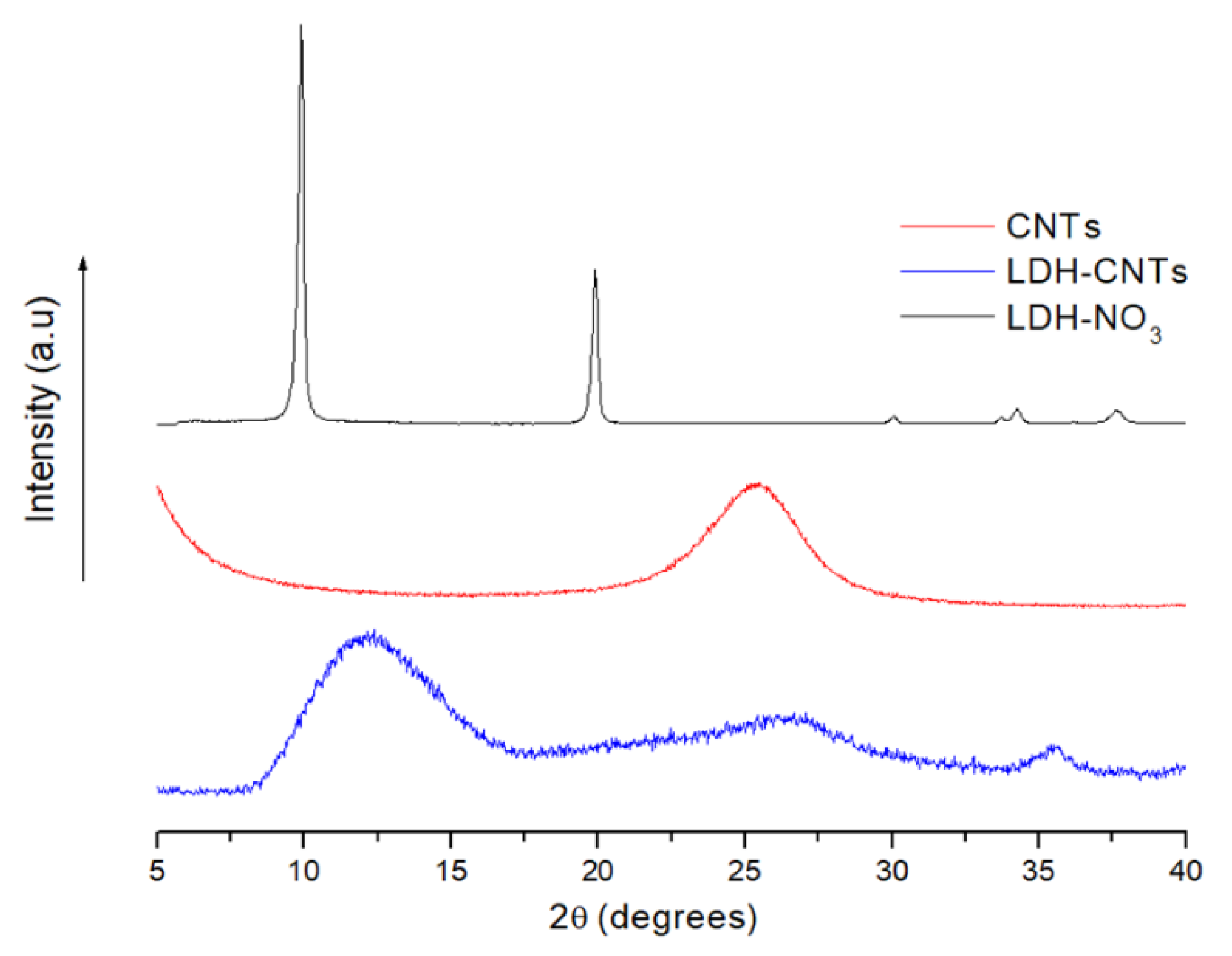
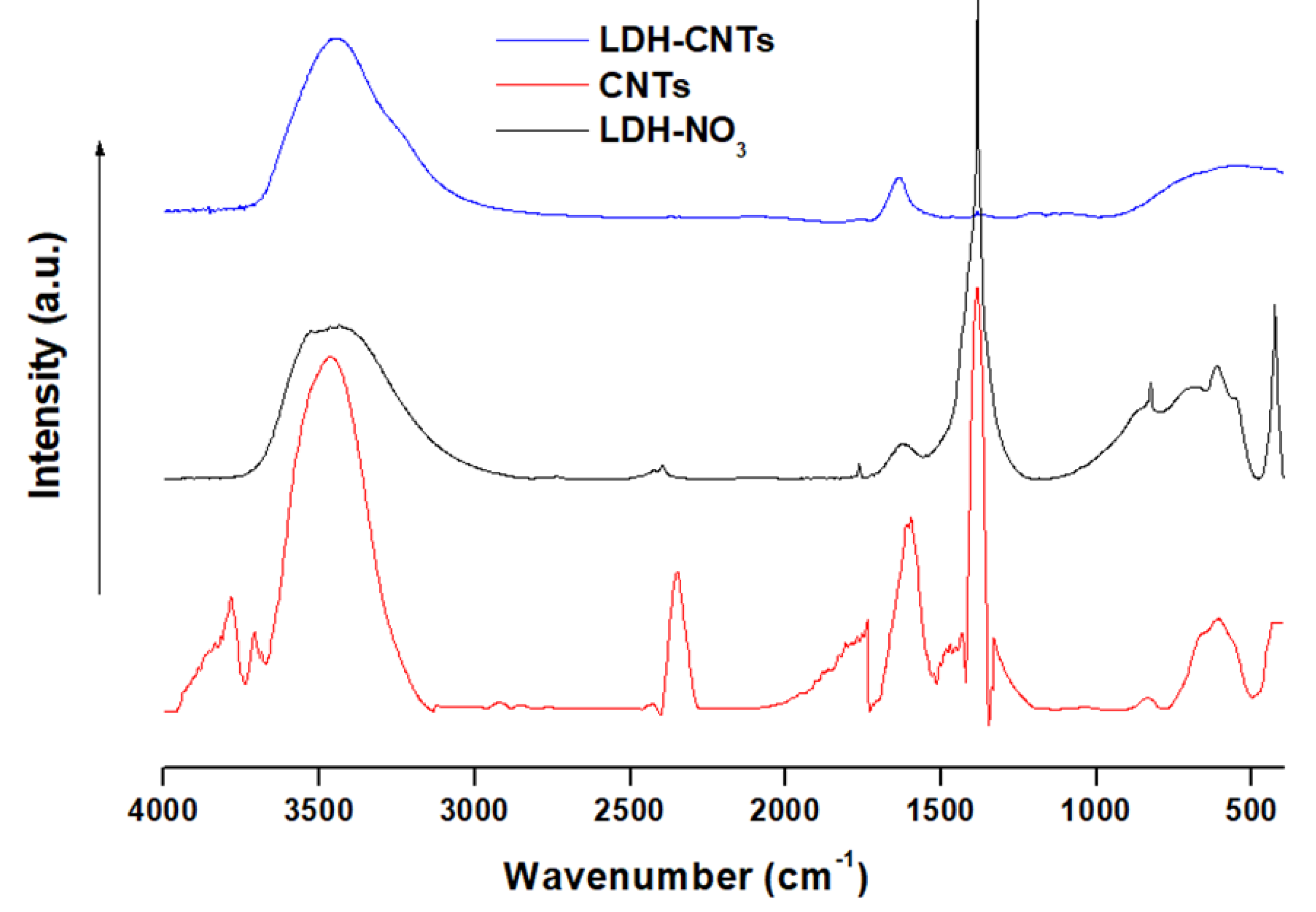
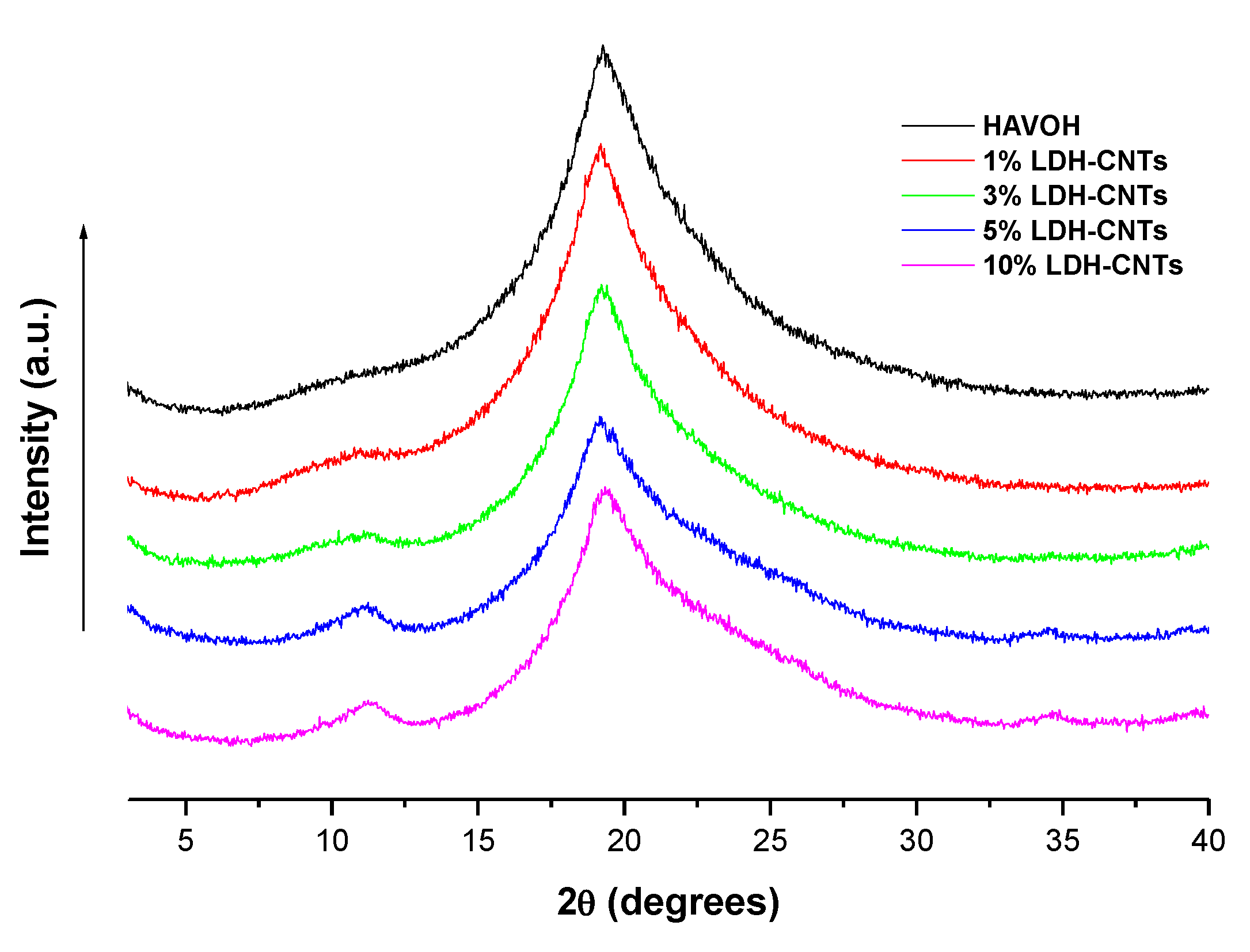
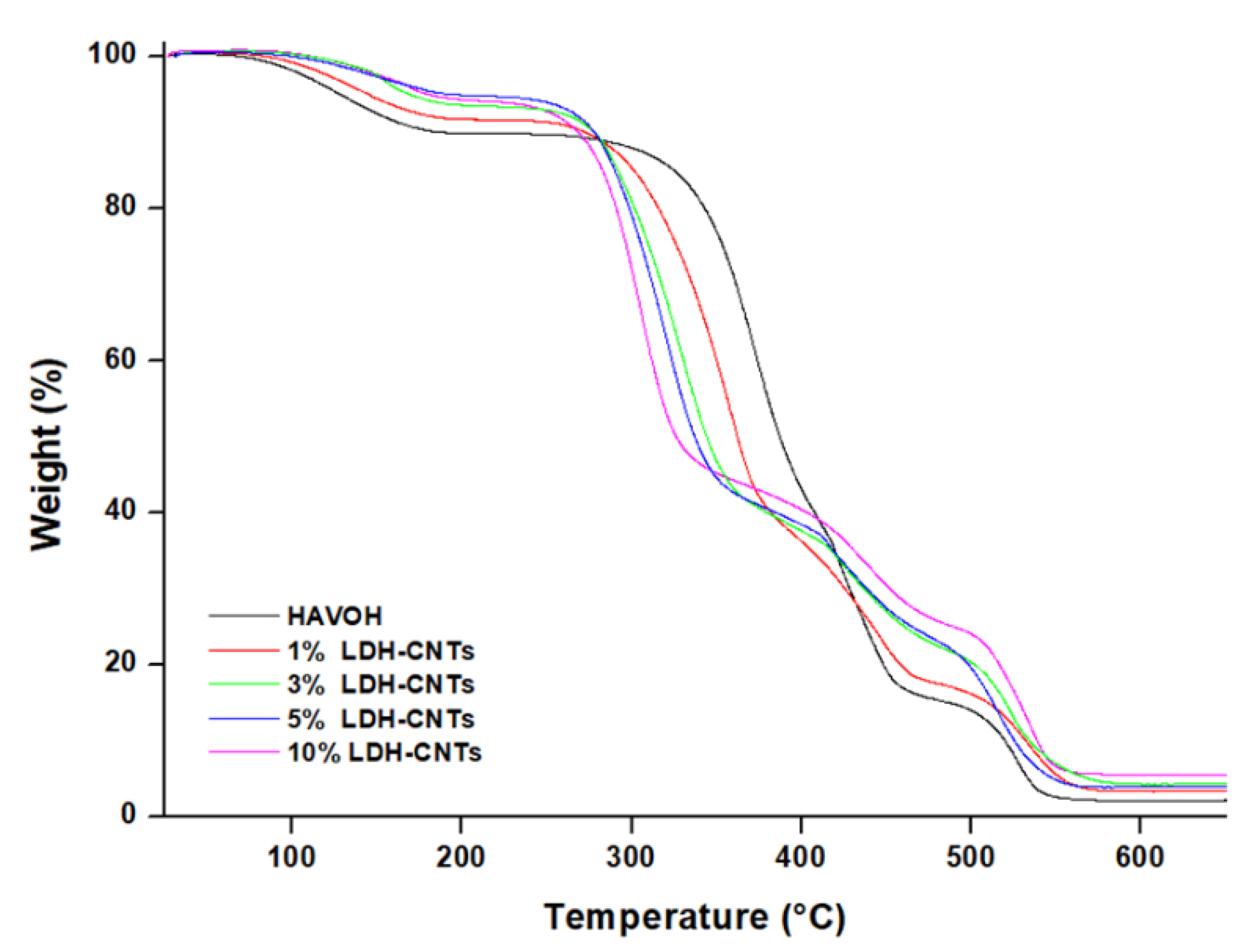
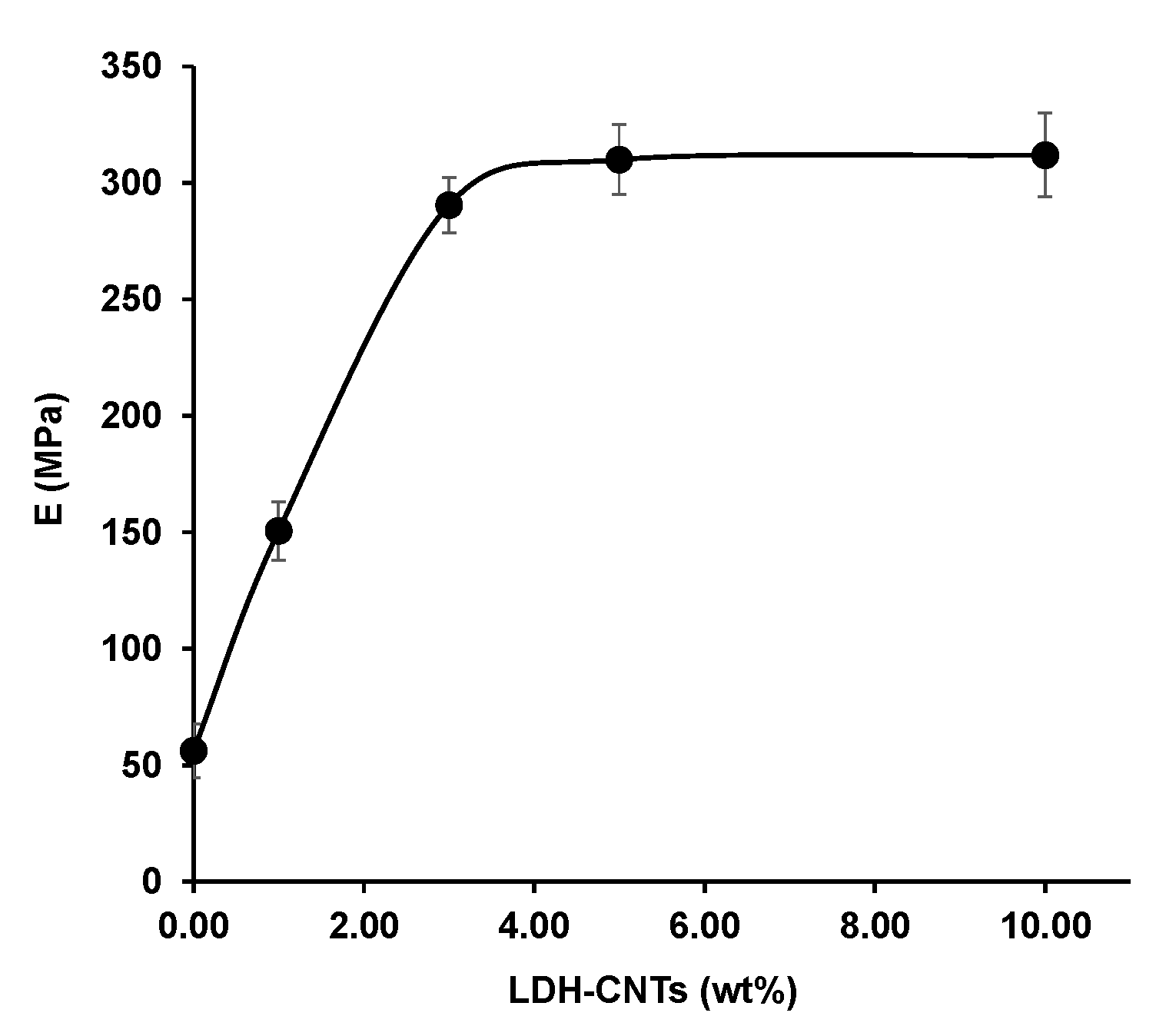
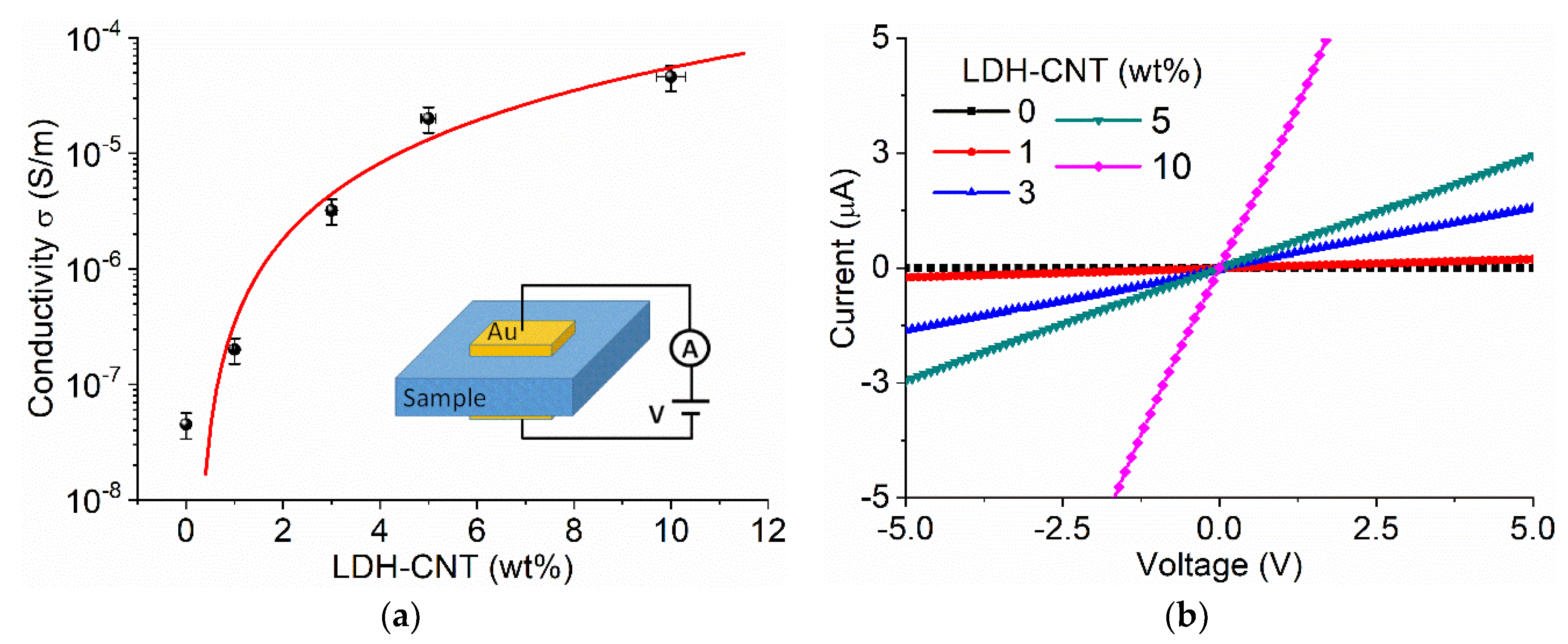
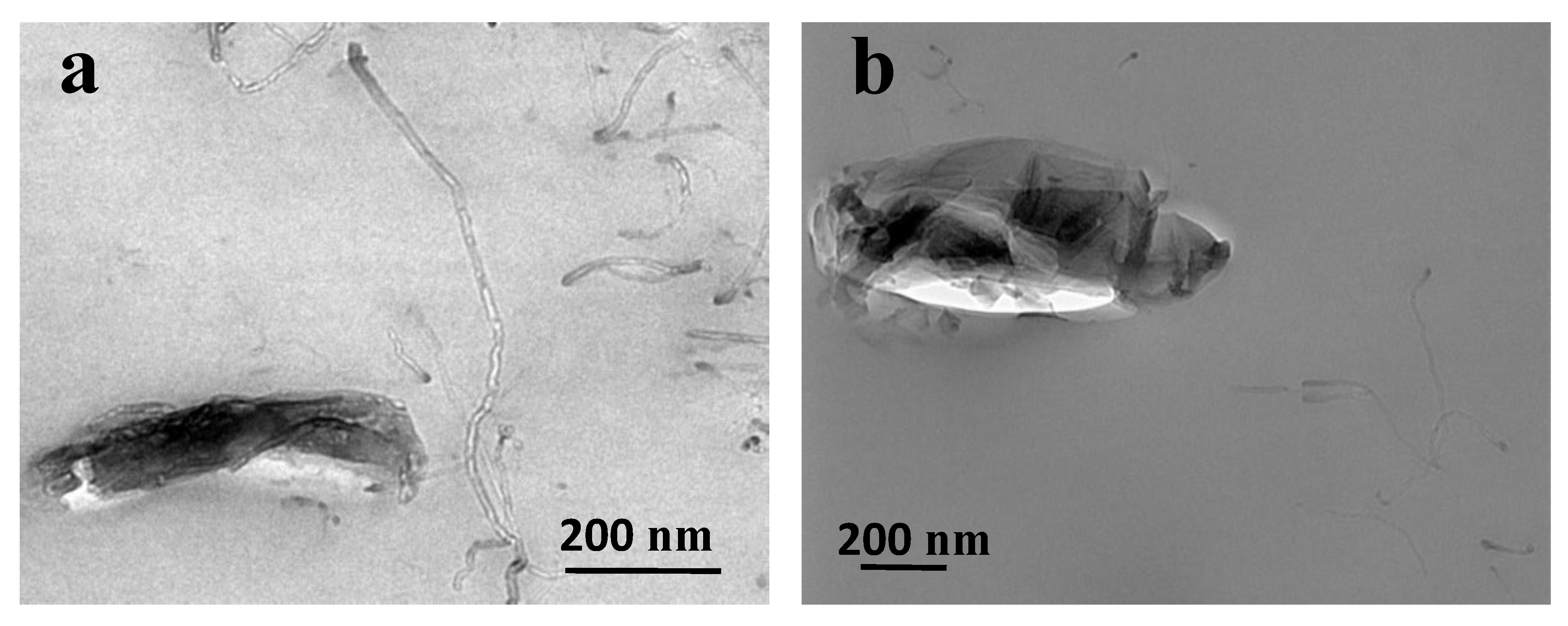
| Zn | Al | C | H | |
|---|---|---|---|---|
| % | 7.2 | 1.4 | 60.4 | 0.82 |
| Grams | 7.2 | 1.4 | 60.4 | 0.82 |
| Moles | 0.11 | 0.05 | 5.03 | 0.82 |
| Molar ratio | 2.1 | 1.0 | 96.5 | 16 |
© 2020 by the authors. Licensee MDPI, Basel, Switzerland. This article is an open access article distributed under the terms and conditions of the Creative Commons Attribution (CC BY) license (http://creativecommons.org/licenses/by/4.0/).
Share and Cite
Bugatti, V.; Viscusi, G.; Di Bartolomeo, A.; Iemmo, L.; Zampino, D.C.; Vittoria, V.; Gorrasi, G. Ionic Liquid as Dispersing Agent of LDH-Carbon Nanotubes into a Biodegradable Vinyl Alcohol Polymer. Polymers 2020, 12, 495. https://doi.org/10.3390/polym12020495
Bugatti V, Viscusi G, Di Bartolomeo A, Iemmo L, Zampino DC, Vittoria V, Gorrasi G. Ionic Liquid as Dispersing Agent of LDH-Carbon Nanotubes into a Biodegradable Vinyl Alcohol Polymer. Polymers. 2020; 12(2):495. https://doi.org/10.3390/polym12020495
Chicago/Turabian StyleBugatti, Valeria, Gianluca Viscusi, Antonio Di Bartolomeo, Laura Iemmo, Daniela Clotilde Zampino, Vittoria Vittoria, and Giuliana Gorrasi. 2020. "Ionic Liquid as Dispersing Agent of LDH-Carbon Nanotubes into a Biodegradable Vinyl Alcohol Polymer" Polymers 12, no. 2: 495. https://doi.org/10.3390/polym12020495
APA StyleBugatti, V., Viscusi, G., Di Bartolomeo, A., Iemmo, L., Zampino, D. C., Vittoria, V., & Gorrasi, G. (2020). Ionic Liquid as Dispersing Agent of LDH-Carbon Nanotubes into a Biodegradable Vinyl Alcohol Polymer. Polymers, 12(2), 495. https://doi.org/10.3390/polym12020495








